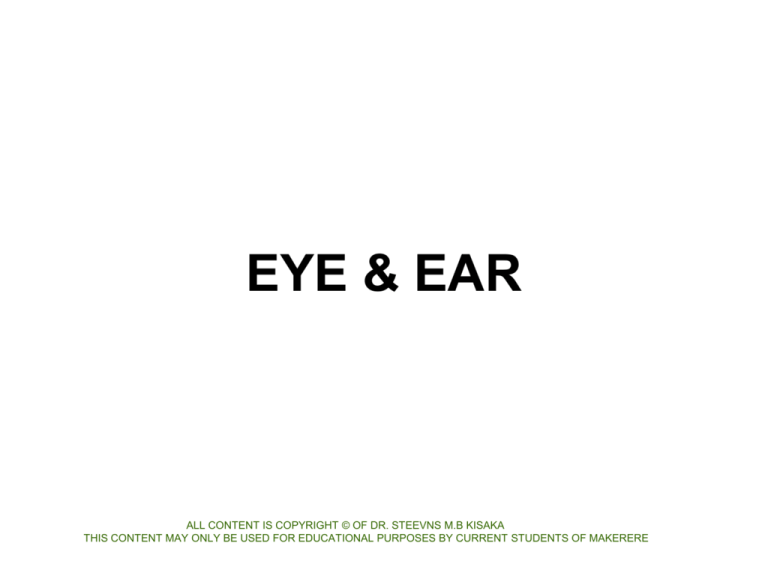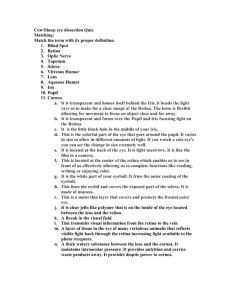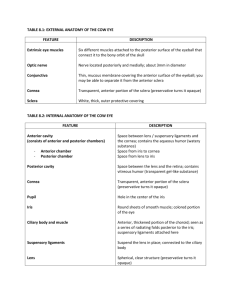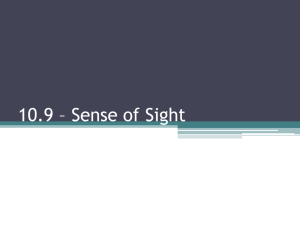EYE & EAR
advertisement

EYE & EAR ALL CONTENT IS COPYRIGHT © OF DR. STEEVNS M.B KISAKA THIS CONTENT MAY ONLY BE USED FOR EDUCATIONAL PURPOSES BY CURRENT STUDENTS OF MAKERERE Objectives 1. Recognise and describe a section of neural retina, identifying areas of histogenesis with lamination/stratification and the adjacent choroid and scleral layers. 2. Recognise and describe a section of cornea, distinguishing areas of limbus-like character, as well as Descemet’s and Bowman’s membranes. 3. Be able to describe and recognise various stages in the development of optic vesicles, the differentiation of the optic cup, lens and adjacent structures, including : developing ciliary body and anterior and posterior chambers of the eye. 4. Distinguish between otic vesicles at various stages of their development and their spatial relationship with portions of the pharynx and developing cochlea in histological section. SLIDE 200 Retina dog Examine this section at low magnification and identify : 1. Cornea. 5. Non- neural retina. 9. 2. Iris. 6. Neural retina. 10. 3. Ciliary apparatus. 7. Choroid. 11. 4. Corneal limbus. 8. Sclera. 1.0 mm Anterior chamber. Posterior chamber. Cavity of vitreous humor. SLIDE 200 Retina dog Examine this section at low magnification and identify : 1. Cornea. 5. Non- neural retina. 9. 2. Iris. 6. Neural retina. 10. 3. Ciliary apparatus. 7. Choroid. 11. 4. Corneal limbus. 8. Sclera. Anterior chamber. Posterior chamber. Cavity of vitreous humor. 2 11 3 10 5 9 1 4 7 8 1.0 mm 6 SLIDE 200 Retina dog Examine this section at low magnification and identify : 1. Cornea. 5. Non- neural retina. 9. 2. Iris. 6. Neural retina. 10. 3. Ciliary apparatus. 7. Choroid. 11. 4. Corneal limbus. 8. Sclera. Anterior chamber. Posterior chamber. Cavity of vitreous humor. 2 11 3 10 5 9 1 4 7 8 1.0 mm 6 SLIDE 200 Cornea dog Identify : 1. Cornea. 2. Iris. 3. Corneal limbus. External eye – Dog ▪ Left eye. Note pigmented epidermis of eyelids. ▪ Identify : Medial canthus Lateral canthus 3rd eyelid Cornea Iris Pupil 250 µm 4. 5. Anterior chamber. Posterior chamber. SLIDE 200 Cornea dog Identify : 1. Cornea. 2. Iris. 3. Corneal limbus. 4. 5. Anterior chamber. Posterior chamber. posterior chamber iris corneal limbus anterior chamber cornea 250 µm SLIDE 200 Cornea dog Examine the cornea at higher magnification. The function of the cornea is ……. 100 µm SLIDE 200 Cornea dog Examine the cornea at higher magnification. The function of the cornea is ……. The cornea has an important role in image formation, it forms a primary refractive element in the eye. anterior posterior 100 µm SLIDE 200 Cornea dog Five layers can be identified in the cornea : 1. anterior epithelium 2. anterior sub-epithelial membrane (lamina) 3. stroma 4. posterior limiting membrane (Descemet’s) 5. posterior epithelium (corneal endothelium) 100 µm SLIDE 200 Cornea dog Five layers can be identified in the cornea : 1. anterior epithelium 2. anterior sub-epithelial membrane (lamina) 3. stroma 4. posterior limiting membrane (Descemet’s) 5. posterior epithelium (corneal endothelium) anterior epithelium posterior epithelium stroma anterior lamina posterior limiting lamina Descemet’s 100 µm SLIDE 200 Cornea dog Identify : Anterior epithelium and anterior sub-epithelial basement membrane. What type of epithelium covers this surface? 25 µm SLIDE 200 Cornea dog Identify : Anterior epithelium and anterior sub-epithelial basement membrane. What type of epithelium covers this surface? Non-keratinised stratified squamous epithelium. anterior epithelium stroma sub-epithelial basement membrane 25 µm SLIDE 200 Cornea dog Identify : Anterior epithelium and anterior sub-epithelial basement membrane. What type of epithelium covers this surface? Non-keratinised stratified squamous epithelium. Consider the cellularity and the extent of the extracellular matrix in these compartments and the cornea ‘proper’. anterior epithelium stroma sub-epithelial basement membrane 25 µm SLIDE 200 Cornea dog Identify : Posterior epithelium (corneal endothelium) and posterior limiting membrane (Descemet’s membrane). What type of epithelium covers this surface? 25 µm SLIDE 200 Cornea dog Identify : Posterior epithelium (corneal endothelium) and posterior limiting membrane (Descemet’s membrane). What type of epithelium covers this surface? Simple squamous epithelium. Note the lack of vasculature in the cornea. Descemet’s membrane stroma posterior epithelium or corneal endothelium 25 µm SLIDE 200 Cornea dog What is the corneal limbus? posterior chamber iris corneal limbus anterior chamber corneal stroma 250 µm SLIDE 200 Cornea dog What is the corneal limbus? The corneo-scleral junction. Here the collagen fibres of the corneal stroma become irregular and blood vessels supplying nutrients to the cornea are seen. The anterior epithelium becomes the conjunctival epithelium. posterior chamber sclera iris corneal limbus anterior chamber conjunctival epithelium posterior epithelium corneal stroma 250 µm anterior epithelium SLIDE 200 Iris dog The iris is the most anterior part of the vascular tunic (uvea) a continuation of the choroid layer. posterior chamber iris corneal limbus anterior chamber cornea 250 µm SLIDE 200 Iris dog The iris is the most anterior part of the vascular tunic (uvea) a continuation of the choroid layer. posterior chamber iris corneal limbus anterior chamber cornea 250 µm SLIDE 200 Iris dog Examine the iris at higher magnification. 50 µm SLIDE 200 Iris dog The iris at higher magnification. posterior chamber pars iridica retinae myoepithelial cells connective tissue stroma BV BV M BV : blood vessels M : melanocytes anterior surface of iris sphincter muscle anterior chamber 50 µm SLIDE 200 Retina dog Through examination observe whether different areas of the retina exhibits neural (thicker) and non neural (thinner) organisation approaching the iris. 100 µm SLIDE 200 Retina dog Through examination observe whether different areas of the retina exhibits neural (thicker) and non neural (thinner) organisation approaching the iris. towards iris non-neural retina edge of neural retina close to edge of neural retina neural retina 100 µm SLIDE 200 Retina dog This non neural portion of the retina approaching the iris consists of two layers of non-light sensitive epithelium. This epithelium is continuous with that covering the ciliary body and iris. 50 µm SLIDE 200 Retina dog This non neural portion of the retina approaching the iris consists of two layers of non-light sensitive epithelium. This epithelium is continuous with that covering the ciliary body and iris. epithelium of non-neural retina choroid 50 µm SLIDE 200 Retina dog This area shows the sudden increase in thickness of the retina as it becomes the neural retina. The junction is called the ora ciliaris retinae. 50 µm SLIDE 200 Retina dog This area shows the sudden increase in thickness of the retina as it becomes the neural retina. The junction is called the ora ciliaris retinae (arrowed). retina choroid sclera space artefact 50 µm SLIDE 200 Retina dog A comparison of the neural retina close to the periphery (left) and at its full thickness (right). Larger blood vessels may be seen in the nerve ganglion cell layer towards the edge of the retina. The individual layers are more easily recognised (right). Note the much thicker layer of rods and cones. 50 µm SLIDE 200 Retina dog A comparison of the neural retina close to the periphery (left) and at its full thickness (right). Larger blood vessels may be seen in the nerve ganglion cell layer towards the edge of the retina. The individual layers are more easily recognised (right). Note the much thicker layer of rods and cones. BV : blood vessel BV layer of rods & cones choroid sclera 50 µm SLIDE 200 Retina dog Examine the neural retina in more detail Observe a full depth portion of this area and identify the different zones. 1. 2. 3. 4. 5. 6. 7. 8. 9. 10. 11. 12. Inner limiting membrane. Nerve fibre layer. Ganglion cell layer. Inner plexiform layer. Inner nuclear layer. Outer plexiform layer. Outer nuclear layer. Outer limiting membrane. Layer of rods and cones. Pigmented epithelium. Choroid layer. Scleral layer. 50 µm SLIDE 200 Retina dog Examine the neural retina in more detail Observe a full depth portion of this area 1 and identify the different zones. 2 3 1. 2. 3. 4. 5. 6. 7. 8. 9. 10. 11. 12. Inner limiting membrane. Nerve fibre layer. Ganglion cell layer. Inner plexiform layer. Inner nuclear layer. Outer plexiform layer. Outer nuclear layer. Outer limiting membrane. Layer of rods and cones. Pigmented epithelium. Choroid layer. Scleral layer. 4 5 6 7 8 9 10 11 50 µm 12 SLIDE 11 Developing head coronal section at level of diencephalon and developing eyes. Identify at low magnification : 1. 2. 3. 4. 5. 6. 7. 8. 9. Oral cavity. Tongue. Developing eyes. Developing nasal cavity. Mandible. Other bones of skull. Developing enamel organs. Developing brain. Eye-lids. 1.0 mm SLIDE 11 Developing head coronal section at level of diencephalon and developing eyes. Identify at low magnification : 1. 2. 3. 4. 5. 6. 7. 8. 9. Oral cavity. Tongue. Developing eyes. Developing nasal cavity. Mandible. Other bones of skull. Developing enamel organs. Developing brain. Eye-lids. 8 6 6 9 4 3 3 9 7 1 7 2 5 1.0 mm 5 SLIDE 11 Developing head coronal section at level of diencephalon and developing eyes. Identify the main regions of the eye. Care should be taken to distinguish between eye chambers and ‘space artefacts’. Identify : 1. Lens. 2. Cornea. 3. Iris. 4. Developing retinal layers. 5. Ciliary body. 6. Eye-lid. 7. Anterior chamber. 8. Vitreous humor. 9. Optic nerve, (may not be visible in all sections). 250 µm SLIDE 11 Developing head coronal section at level of diencephalon and developing eyes. Identify the main regions of the eye. Care should be taken to distinguish between eye chambers and ‘space artefacts’. 6 A 3* 2 8 9 1 7 Identify : 1. Lens. 2. Cornea. 3. Iris. 4. Developing retinal layers. 5. Ciliary body. 6. Eye-lid. 7. Anterior chamber. 8. Vitreous humor. 9. Optic nerve, (may not be visible in all sections). 5* A 4 6 A : space artefacts * Unclear due to distortion of tissue during fixation. 250 µm SLIDE 11 Developing head coronal section at level of diencephalon and developing eyes. At a higher magnification identify: 1. Equator of developing lens. 4. 2. Lens anterior surface epithelium. 5. 3. Optic nerve (may not be visible on all sections). Developing retina. Cornea. 100 µm SLIDE 11 Developing head coronal section at level of diencephalon and developing eyes. At a higher magnification identify: 1. Equator of developing lens. 4. 2. Lens anterior surface epithelium. 5. 3. Optic nerve (may not be visible on all sections). Developing retina. Cornea. E : equator of lens developing retina A anterior epithelium of lens E optic nerve cornea A : space artefacts A 100 µm SLIDE 11 Developing head coronal section at level of diencephalon and developing eyes. How is the diameter of the lens controlled? 100 µm SLIDE 11 Developing head coronal section at level of diencephalon and developing eyes. How is the diameter of the lens controlled? By the contraction and relaxation of the ciliary muscle. cornea lens capsule cuboidal lens epithelium proliferating cells at equator of lens distortion due to fixation; developing iris and ciliary body displaced developing retina 100 µm artefact SLIDE 11 Developing head coronal section at level of diencephalon and developing eyes. At high magnification identify: note the spatial differentiation of the lens fibre cells. The surrounding lens capsule is composed of basal lamina and collagen fibres. The cuboidal epithelial cells on the anterior surface have their bases facing the lens capsule and their apices facing the lens fibres. At the equator of the lens the cells elongate and differentiate into lens fibres forming the body of the lens. These run in an anterior-posterior direction. The fully differentiated fibres are hexagonal in cross section and have lost their nucleus and most cell organelles. 50 µm Demonstration slides with green labels This set of slides is available during classes from the front bench in the teaching lab (or by request). These slides are serial sections through the the head region of developing embryos. They show stages in the early development of the eye and the ear. In the set can be found : 1. 2. 3. 4. Very early stage in development of the eye. Slightly later stage of eye development. Very early stage in development of ear. Slightly later stage in ear development. Remember; if you look at the slides, you will need to search for the section which shows best either the eye or ear. Try also to recognise some of the other developing structures sectioned. SLIDE (green label) Early stage of developing eye In the early embryo, the eyes are first seen as diverticulae developing laterally from the diencephalon. In this section only the optic diverticulum on the right side can be seen. These specimens are often cut at an oblique angle, so the eye on one side will appear before its partner. At this stage of development, the prominent flexure of the head region can result in the section going through both hind-brain and forebrain (and sometimes the spinal cord). 250 µm SLIDE (green label) Early stage of developing eye In the early embryo, the eyes are first seen as diverticulae developing laterally from the diencephalon. spinal cord In this section only the optic diverticulum on the right side can be seen. These specimens are often cut at an oblique angle, so the eye on one side will appear before its partner. At this stage of development, the prominent flexure of the head region can result in the section going through both hind-brain and forebrain (and sometimes the spinal cord). 250 µm diencephalon diocoel* developing optic vesicle pharyngeal pouch * diocoel ═ lumen of diencephalon SLIDE (green label) Early stage of developing eye A few sections along on the same slide and both developing optic vesicles can be seen. 250 µm SLIDE (green label) Early stage of developing eye A few sections along on the same slide and both developing optic vesicles can be seen. diencephalon optic vesicle blood vessels 250 µm optic vesicle SLIDE (green label) Early stage of developing eye Two adjacent sections from another of the slides showing the early stages in the development of the eye. The optic vesicles are well developed and due to the flexure in the head an area of mid-hind brain can be seen. Note the embryonic membranes. 100 µm SLIDE (green label) Early stage of developing eye Two adjacent sections from another of the slides showing the early stages in the development of the eye. The optic vesicles are well developed and due to the flexure in the head an area of mid-hind brain can be seen. Note the embryonic membranes. branches of vitelline vein wall of diencephalon amnion optic vesicles 100 µm amniotic cavity SLIDE (green label) Later stage of developing eye The diverticulae (seen in the previous slide), invaginate to form the optic cup. Producing the retina, ciliary layers and iris. The lens is formed from modified epithelial cells; the surface ectoderm overlying the optic cup. The apparent discontinuity between the diencephalon and the retinal layer of the optic cup is because of the shape of the cup and the plane of the section. 250 µm SLIDE (green label) Later stage of developing eye The diverticulae (seen in the previous slide), invaginate to form the optic cup. Producing the retina, ciliary layers and iris. The lens is formed from modified epithelial cells; the surface ectoderm overlying the optic cup. amniotic cavity diencephalon retina diocoel optic cup anterior cardinal vein The apparent discontinuity between the diencephalon and the retinal layer of the optic cup is because of the shape of the cup and the plane of the section. 250 µm lens choroid layer myelencephalon (with thin roof) SLIDE (green label) Early stage of developing ear The otic vesicles arise from otic (auditory) placodes (areas of thickened ectoderm) level with the posterior part of the brain. These sink below the surface to form auditory pits becoming auditory or otic vesicles. 100 µm SLIDE (green label) Early stage of developing ear The otic vesicles arise from otic (auditory) placodes (areas of thickened ectoderm) level with the posterior part of the brain. These sink below the surface to form auditory pits becoming auditory or otic vesicles. myelencephalon OV : otic vesicles OV OV amniotic cavity neural tube developing heart 100 µm SLIDE (green label) Early stage of developing ear Again see how the appearance of the otic vesicles can vary in these serial sections. 100 µm SLIDE (green label) Early stage of developing ear Previous section at a slightly higher magnification showing some of the associated structures. 100 µm SLIDE (green label) Early stage of developing ear Previous section at a slightly higher magnification showing some of the associated structures. vesicle closing myelencephalon with thin roof otic vesicle anterior cardinal vein notochord pharynx internal carotid artery 100 µm SLIDE (green label) Later stage of developing ear The auditory or otic vesicles, have lost their connection to the surface and are now forming the inner portion of the ear. The first pharangeal (hyomandibular) pouch will give rise to the Eustachian tube and the chamber of the middle ear. 0.5 mm SLIDE (green label) Later stage of developing ear The auditory or otic vesicles, have lost their connection to the surface and are now forming the inner portion of the ear. The first pharangeal (hyomandibular) pouch will give rise to the Eustachian tube and the chamber of the middle ear. OV : otic vesicles myelencephalon OV OV OV pharyngeal pouch visceral arch pharyngeal pouch 0.5 mm OV SLIDE (green label) Later stage of developing ear Note the close proximity of the first pharyngeal pouch to the otic vesicle. Also note developing nerve fibres in the vicinity of the otic vesicle. 250 µm 100 µm SLIDE (green label) Later stage of developing ear Note the close proximity of the first pharyngeal pouch to the otic vesicle. Also note developing nerve fibres in the vicinity of the otic vesicle. N : nerve fibre P : pharyngeal pouch otic vesicle N P N 250 µm 100 µm SLIDE (green label) Later stage of developing ear The same specimen, but a few sections along the slide. Note the change in shape of the otic vesicle; early stages in the formation of the semicircular canals. Also note the more prominent nervous tissue/ganglia (arrowed). 250 µm 100 µm Lecturer: Dr. MBS Kisaka Slides and Stains: Monica Nambi







